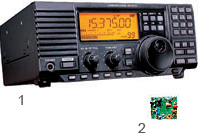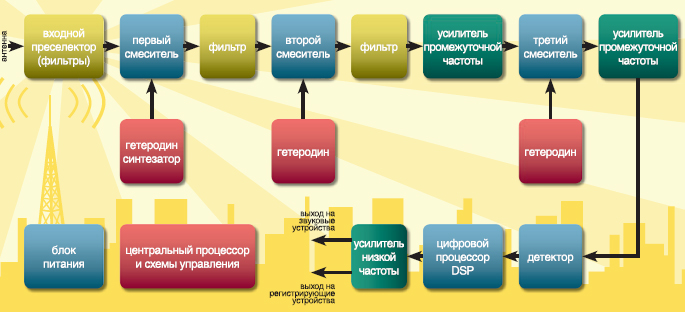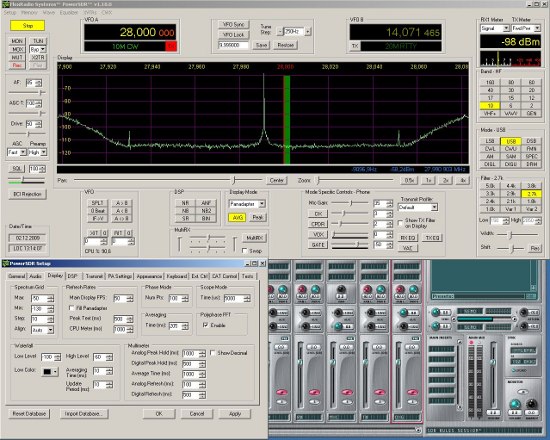Radio technology of the 21st century
I think the topic should start with what is for you receiver? This is such a thing with a bunch of parts, always with coils and frequency control. It does not matter if the receiver has a digital display, or just a twist to select a frequency, or is it a TV tuner in your computer and controlled from a computer. They all have a general principle of construction, it would seem impossible to invent something new. Now we will turn your understanding of the receivers, what they were and what they have become, without particularly delving into the subtleties.
 Take a look: the receivers presented in the figure (No. 1 is a professional communication receiver, No. 2 is a receiver assembled according to a new technology of digital modeling) are equal in characteristics; besides the receiver number 2 is also a multifunctional measuring instrument! (Of course, a computer is needed for the operation of the new receiver, but more on that later.)
Take a look: the receivers presented in the figure (No. 1 is a professional communication receiver, No. 2 is a receiver assembled according to a new technology of digital modeling) are equal in characteristics; besides the receiver number 2 is also a multifunctional measuring instrument! (Of course, a computer is needed for the operation of the new receiver, but more on that later.)
How can you replace a professional receiver with a small scarf, and even with equal characteristics? It would seem impossible! That was before the advent of software-defined radio (SDR), a radio communication system in which software is used, both for modulation and for demodulation of radio signals. The SDR changes priorities, and the personal computer becomes the core of an amateur radio station.
')
Let's start with the name of the new technology: SDR (Software Defined Radio). Translated into Russian, this means "software defined (dependent) radio." What is this radio “definable” and on which programs it “depends”? The very principle of building a receiver, which consists of two parts: a small circuit part and software, looks uncommon. This is the main burden for the software.
In fact, the computer simulates all the nodes of the receiver software. And it does it with the highest quality. The share of "iron" are only the first three "square" in the figure: brown, blue and red, but they are simplified to the limit. Even the power can now be taken from the USB port of the computer.
The figure below shows the scheme of the simplest SDR receiver.

So, the signal from the antenna is fed through a filter (you can also through the low-pass filter) to high-speed switches. Much depends on these keys, so they must be of good quality (fast-acting, with low transient and high resistance of the off state, etc.). Two operational amplifiers are connected to the outputs of the keys. For amplifiers, too, high demands. There is nothing to write about the heterodyne (synthesizer).
Using the standard chip DDS synthesizer (Direct Digital Synthesis - a digital synthesizer of direct synthesis) and dividers with signal outputs that are shifted by 90 degrees, you can block the range that you need. That's the whole receiver, in the simplest version.
For comparison, below is a block diagram of a modern receiver.

So back to the consideration of a digital SDR receiver, fig. 1. From the output of the operational amplifiers, the signal is transmitted to the left and right channels of the audio card. The program does everything else: it processes the signal, rebuilds the receiver over a range (controlled DDS is used), models the necessary filters (and with such characteristics that cannot be obtained in hardware), simulates AGC operation (much better than in the “real” receiver), has A panoramic indicator that displays a spectrogram (which shows the situation on the air) measures signal levels and much, much more. That is, using digital signal processing, we can realize what we would like, as well as adjust the parameters in a wide range.
SDR technology offers a panorama; at the same time, the operator has access to visual monitoring in real time on the computer monitor for signals in the frequency band determined by the sampling frequency of the sound card (48, 96 or 192 kHz), as well as the ability to improve the functionality of the SDR receiver by improving the software. Imagine that you no longer need to buy a new device every time - you just need to download and update the program.
This is how the SDR receiver interface looks, looking at the picture you can imagine what powerful functionality is inherent in this technology. Impressive, isn't it? Especially if you understand why all these buttons;)

In addition to monitoring with very good visibility, control programs for SDR allow you to make high-quality recording of the received signal and relay it to your correspondent, record the state of the air in the frequency band and subsequently reproduce it, choose any filter bandwidth from 10 Hz to 20 kHz with good slope, and any modes of operation.
In addition, the SDR receiver is also a spectrum analyzer that allows the operator to fully evaluate the signals received by radio stations. Special prospects SDR equipment can give those who work on the VHF bands. By connecting a VHF transverter to the SDR transceiver, it becomes possible to monitor the presence and activity of radio stations in a fairly wide frequency band.
It cannot be said that the technology of Software Defined Radio is young, since the military have been using it for a long time in their equipment. From a commercial point of view, technology can be considered quite young and rapidly developing. Components for digital signal processing, analog-digital and digital-analog conversion are improving and becoming cheaper every day, which constantly brings the output of SDR technology to the masses. As was shown in this article, the complexity of the design of traditional receivers is significantly higher than that of the SDR, not to mention the fact that the former lack any flexibility that is so necessary in modern conditions for rapidly changing standards. Therefore, a total transition to the SDR architecture is inevitable, it is only a matter of time.
When writing this text used several sources. More information about the technology can be found here.
offline.computerra.ru/2007/685/318163
And for those who want to try to control and share the air with such a receiver without getting up from behind the computer, I suggest visiting this link
http://websdr.ewi.utwente.nl:8901/ . A JRE (Java Runtime Environment) and a channel of at least 512 kbit / s are required for operation. I managed to receive radio amateurs from Russia and the CIS. The receiver itself is located in the Netherlands and allows access to as many users as the outgoing channel allows. All signal processing takes place on your computer.
 Take a look: the receivers presented in the figure (No. 1 is a professional communication receiver, No. 2 is a receiver assembled according to a new technology of digital modeling) are equal in characteristics; besides the receiver number 2 is also a multifunctional measuring instrument! (Of course, a computer is needed for the operation of the new receiver, but more on that later.)
Take a look: the receivers presented in the figure (No. 1 is a professional communication receiver, No. 2 is a receiver assembled according to a new technology of digital modeling) are equal in characteristics; besides the receiver number 2 is also a multifunctional measuring instrument! (Of course, a computer is needed for the operation of the new receiver, but more on that later.)How can you replace a professional receiver with a small scarf, and even with equal characteristics? It would seem impossible! That was before the advent of software-defined radio (SDR), a radio communication system in which software is used, both for modulation and for demodulation of radio signals. The SDR changes priorities, and the personal computer becomes the core of an amateur radio station.
')
Let's start with the name of the new technology: SDR (Software Defined Radio). Translated into Russian, this means "software defined (dependent) radio." What is this radio “definable” and on which programs it “depends”? The very principle of building a receiver, which consists of two parts: a small circuit part and software, looks uncommon. This is the main burden for the software.
In fact, the computer simulates all the nodes of the receiver software. And it does it with the highest quality. The share of "iron" are only the first three "square" in the figure: brown, blue and red, but they are simplified to the limit. Even the power can now be taken from the USB port of the computer.
The figure below shows the scheme of the simplest SDR receiver.

So, the signal from the antenna is fed through a filter (you can also through the low-pass filter) to high-speed switches. Much depends on these keys, so they must be of good quality (fast-acting, with low transient and high resistance of the off state, etc.). Two operational amplifiers are connected to the outputs of the keys. For amplifiers, too, high demands. There is nothing to write about the heterodyne (synthesizer).
Using the standard chip DDS synthesizer (Direct Digital Synthesis - a digital synthesizer of direct synthesis) and dividers with signal outputs that are shifted by 90 degrees, you can block the range that you need. That's the whole receiver, in the simplest version.
For comparison, below is a block diagram of a modern receiver.

So back to the consideration of a digital SDR receiver, fig. 1. From the output of the operational amplifiers, the signal is transmitted to the left and right channels of the audio card. The program does everything else: it processes the signal, rebuilds the receiver over a range (controlled DDS is used), models the necessary filters (and with such characteristics that cannot be obtained in hardware), simulates AGC operation (much better than in the “real” receiver), has A panoramic indicator that displays a spectrogram (which shows the situation on the air) measures signal levels and much, much more. That is, using digital signal processing, we can realize what we would like, as well as adjust the parameters in a wide range.
SDR technology offers a panorama; at the same time, the operator has access to visual monitoring in real time on the computer monitor for signals in the frequency band determined by the sampling frequency of the sound card (48, 96 or 192 kHz), as well as the ability to improve the functionality of the SDR receiver by improving the software. Imagine that you no longer need to buy a new device every time - you just need to download and update the program.
This is how the SDR receiver interface looks, looking at the picture you can imagine what powerful functionality is inherent in this technology. Impressive, isn't it? Especially if you understand why all these buttons;)

In addition to monitoring with very good visibility, control programs for SDR allow you to make high-quality recording of the received signal and relay it to your correspondent, record the state of the air in the frequency band and subsequently reproduce it, choose any filter bandwidth from 10 Hz to 20 kHz with good slope, and any modes of operation.
In addition, the SDR receiver is also a spectrum analyzer that allows the operator to fully evaluate the signals received by radio stations. Special prospects SDR equipment can give those who work on the VHF bands. By connecting a VHF transverter to the SDR transceiver, it becomes possible to monitor the presence and activity of radio stations in a fairly wide frequency band.
Conclusion
It cannot be said that the technology of Software Defined Radio is young, since the military have been using it for a long time in their equipment. From a commercial point of view, technology can be considered quite young and rapidly developing. Components for digital signal processing, analog-digital and digital-analog conversion are improving and becoming cheaper every day, which constantly brings the output of SDR technology to the masses. As was shown in this article, the complexity of the design of traditional receivers is significantly higher than that of the SDR, not to mention the fact that the former lack any flexibility that is so necessary in modern conditions for rapidly changing standards. Therefore, a total transition to the SDR architecture is inevitable, it is only a matter of time.
When writing this text used several sources. More information about the technology can be found here.
offline.computerra.ru/2007/685/318163
And for those who want to try to control and share the air with such a receiver without getting up from behind the computer, I suggest visiting this link
http://websdr.ewi.utwente.nl:8901/ . A JRE (Java Runtime Environment) and a channel of at least 512 kbit / s are required for operation. I managed to receive radio amateurs from Russia and the CIS. The receiver itself is located in the Netherlands and allows access to as many users as the outgoing channel allows. All signal processing takes place on your computer.
Source: https://habr.com/ru/post/95542/
All Articles